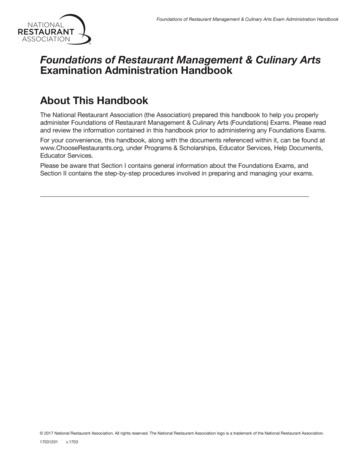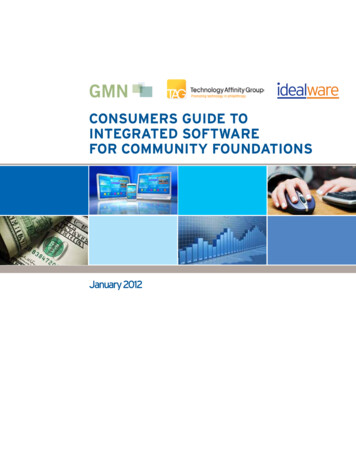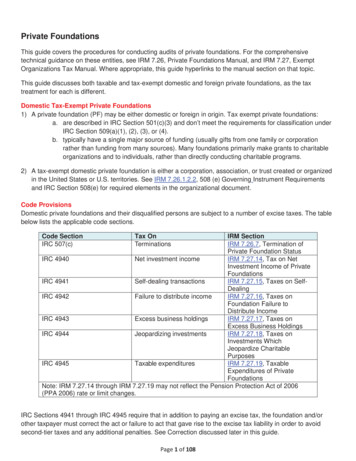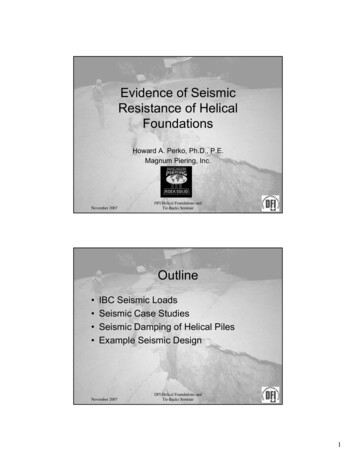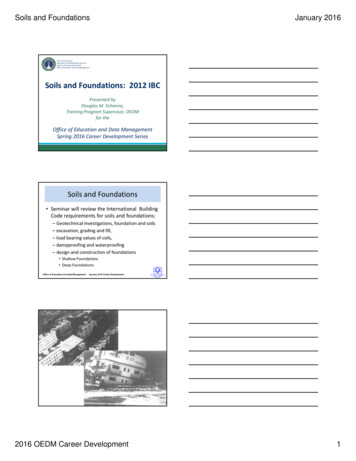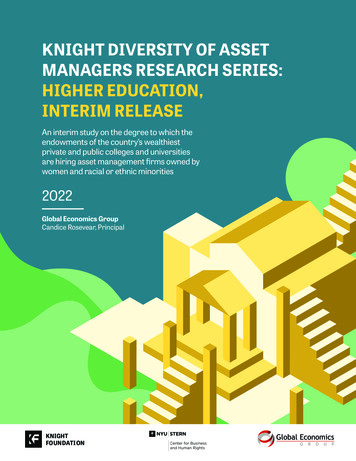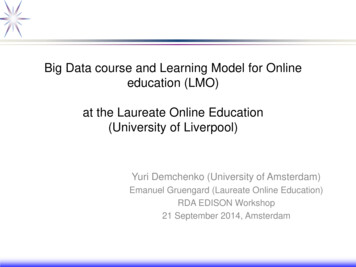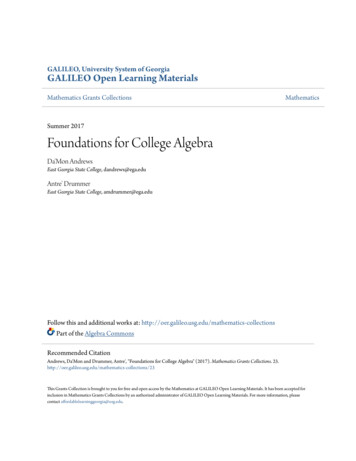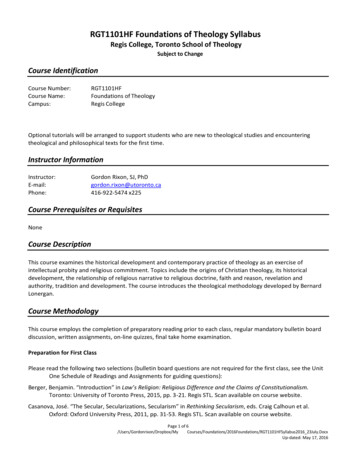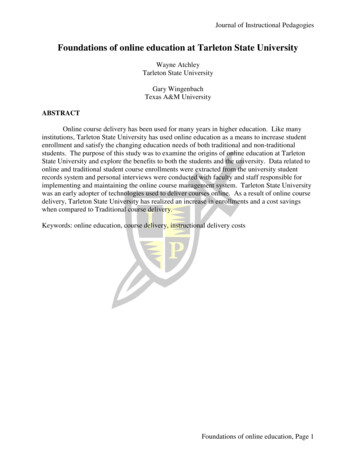
Transcription
Journal of Instructional PedagogiesFoundations of online education at Tarleton State UniversityWayne AtchleyTarleton State UniversityGary WingenbachTexas A&M UniversityABSTRACTOnline course delivery has been used for many years in higher education. Like manyinstitutions, Tarleton State University has used online education as a means to increase studentenrollment and satisfy the changing education needs of both traditional and non-traditionalstudents. The purpose of this study was to examine the origins of online education at TarletonState University and explore the benefits to both the students and the university. Data related toonline and traditional student course enrollments were extracted from the university studentrecords system and personal interviews were conducted with faculty and staff responsible forimplementing and maintaining the online course management system. Tarleton State Universitywas an early adopter of technologies used to deliver courses online. As a result of online coursedelivery, Tarleton State University has realized an increase in enrollments and a cost savingswhen compared to Traditional course delivery.Keywords: online education, course delivery, instructional delivery costsFoundations of online education, Page 1
Journal of Instructional PedagogiesINTRODUCTIONThe first documented example of a completely online educational program occurred in1982 at the Western Behavioral Sciences Institute (WBSI) (Feenberg, 1993; Harasim, 2000).Since that time, online education has experienced rapid growth (Allen & Seaman, 2008).According to a survey conducted by the Sloan Foundation, there was a 35% growth in onlineenrollments from 2004 to 2005 (Allen & Seaman, 2006). As of fall 2007, more than 3.9 millionstudents were enrolled in at least one online course representing more than 20% of all students inhigher education (Allen & Seaman, 2007).The student benefits of online education include flexibility, convenience, and in the caseof non-traditional students, access to higher education (Lee, Cheung, & Chen, 2005; Matthews,1999; Richardson & Swan, 2003; van Shaik, Barker, & Beckstrand, 2003). From theinstitution’s perspective, benefits can include increased enrollment and reduced overhead fromteaching traditional courses (Matthews).Research about the origins of online education included the history of collaborationbetween researchers working on the Department of Defense’s Advanced Research ProjectsAgencies network (ARPANET) (Harasim, 2000; Waldrop, 2008), the first online programofferings at the WBSI (Feenberg, 1993), and the growth of online course offerings amonguniversities as an alternative delivery format (Allen & Seaman, 2008).According to George Mollick, former director of the Center for Instructional Technologyand Distributed Education (CITDE) at Tarleton State University, the adoption of online coursedelivery at Tarleton State University took several years and was the result of a push from thefaculty (personal communication, February 17, 2010). As of fall 2008, roughly 13% of allstudents at Tarleton State University were enrolled in at least one online course. Despite theubiquitous nature of online education, no research was found that clearly identified its originsand/or use as an educational delivery system at Tarleton State University.PURPOSE AND OBJECTIVESThe purpose of this study was to document the historical foundations for online educationand to identify its growth at Tarleton State University, Stephenville, Texas.Two objectives guided this study. The first objective was to describe the origins ofonline education as an extension of the broader field of distance education. The second objectivewas to describe the history and current state of online education at Tarleton State University.HISTORYOnline course delivery may take many forms, but Harasim defines an online course asone whose primary mode of instruction takes place using the web (2000). Allen and Seaman(2008) defined an online course as “A course where most or all of the content is delivered online.Typically have no face-to-face meetings.” (p. 4) Additionally, an online course does not requirea synchronous connection between the student and instructor. One of the most often citedbenefits of online education is the ability to take courses wherever and whenever it is convenientfor the learner (Matthews, 1999; Richardson & Swan, 2003). Online courses also benefit theinstructor by allowing them the freedom to administer and facilitate the course from their homeor office and without the need to occupy a classroom.Foundations of online education, Page 2
Journal of Instructional PedagogiesTo better understand the history of online education, the technologies that made it areality are described in the following sections. The innovations that made online educationpossible included the Internet, e-mail, and the World Wide Web.The ARPANETThe earliest widespread use of computer networks for collaboration between universitiesbegan with the creation of a multi-site network by the Advanced Research Projects Agency(ARPA) of the Department of Defense. This network came to be known as the ARPANET. Theproject started with a memo from Joseph Carl Robnett Licklider, head of the computer researchprogram at DARPA, on April 23, 1963 (Waldrop, 2008). According to Bolt, Beranek, andNewman, Inc. (BBN, 1981), there were two original objectives for the ARPA Program:(1) To develop techniques and obtain experience on interconnecting computers in such away that a very broad class of interactions are possible, and (2) To improve and increasecomputer research productivity through resource sharing. (p. 9)Many of the technologies required to make the ARPANET a reality were already createdand in use on smaller networks, but most needed additional refinement for use on the scaleneeded by the Department of Defense (BBN, 1981). After several years of development andprogramming by the researchers at ARPA, the first message was sent via the ARPANETbetween UCLA and the Stanford Research Institute on October 29, 1969. By December 1970,the ARPANET consisted of 13 computers (nodes) connected via leased phone lines from AT&T.The phones lines provided an always-on connection between the different sites on the network.Leasing the existing phone lines from AT&T greatly reduced the installation costs of the networkand is still a solution that is widely used today (Waldrop, 2008).The Birth of Electronic MailIn 1971, an electronic mail (e-mail) program for the ARPANET was created by RayTomlinson, one of the project leaders at BBN (Leiner et al., 1997). The concept of e-mail wasnot new at the time. Local e-mail was already being used on the time sharing computers at otherARPA projects. However, Tomlinson decided to implement e-mail on a larger scale so it couldbe used across the entire ARPANET. Since the ARPANET was comprised of multiplecomputers, a solution was required that would direct the e-mail to the correct user on the correctcomputer. Tomlinson’s solution was to create a unique address for all recipients on theARPANET. His solution is still the standard for all e-mail addresses: username@hostname(Hobbes, 2010; Waldrop, 2008).E-mail took the place of interoffice memos and allowed someone to send an electronicmessage across physical barriers. No longer was it necessary to mail a letter or send typedmemos through the U.S. postal physical delivery processes. It was not long before e-mail wasthe “most popular application on the network.” (Waldrop, 2008, p. 83)Throughout the 1970s and 1980s, e-mail was used in educational settings first to facilitateinformation exchange and then as a way to supplement university-level courses (Harasim, 2000).For distance education purposes, e-mail and the growth of computer networks alloweduniversities to expand course offerings and reach students that would not normally have access tothe universities facilities. Using the new technologies, the university could grow enrollmentswithout necessarily having to add additional classroom space (Matthews, 1999).Foundations of online education, Page 3
Journal of Instructional PedagogiesFor most of the 1970s online collaboration between student and teacher was largelylimited to e-mail (Harasim, 2000; Matthews, 1999) or asynchronous delivery of information(Feenberg, 1993; Harasim). Starting in the 1980s, online collaborative learning using computerconferencing started to emerge. Using computer conferencing systems, students were able tointeract synchronously and faculty began to adopt group learning activities (Harasim).World Wide WebHaving worldwide communication and access to data was a huge breakthrough forinstruction, collaboration, and research purposes. However, there was no easily accessible wayfor the effective management of the available data. Information was still stored on differentsystems and in different formats.Several organizations were using a form of hypertext to link and organize data, but until1989, no one had thought to link the use of hypertext with the Internet (Gillies & Cailliau, 2000).In March of 1989, Tim Berners-Lee created a proposal for what would become the World WideWeb. Berners-Lee was working for the European Council for Nuclear Research (CERN) whenhe was given the freedom to explore and create the foundations of the World Wide Web. Usinga NeXT computer system, Berners-Lee created the first web-browser and by December of 1990had a working prototype of the web-browser and server (Gillies & Cailliau). This early browserdid not support a mixture of graphics and text, but that innovation would soon follow.In 1991, the Internet became available for commercial use (Gillies & Cailliau, 2000).While Internet and World Wide Web are used almost interchangeably in common language, theWorld Wide Web is just one branch of the broader Internet. Specifically the World Wide Webconsists of all the HTML documents stored on all servers across the Internet that are transmittedusing the Hyper Text Transfer Protocol (HTTP) (Gillies & Cailliau; Merriam-Webster.com.com,n.d.). Merriam-Webster’s online dictionary defines the Internet as “an electroniccommunications network that connects computer networks and organizational computer facilitiesaround the world” (n.d.).Now that the Internet was available for commercial use and the World Wide Webfacilitated the organization and distribution of content, the growth of distance education usingonline course delivery was ready to expand. In 1993, the Mosaic web browser was released(Andreessen & Bina, 1994; Hobbes, 2010) and was the first successful browser to deliver webcontent that contained graphics and text in a single web page (Andreessen & Bina). By 1995, theWorld Wide Web became the Internet service with the most traffic based on amount of datasent/received (Hobbes).In the United States, less than 10 states had online education programs in 1992. By 2004,all 50 states had some form of online learning programs available at the college level (Lynch,2004). According to a survey conducted by the Allen and Seaman (2008) in fall 2002, onlineenrollments represented 9.6% of the total number of students enrolled in degree-grantingpostsecondary institutions. In fall 2007, online enrollments as a percentage of total enrollmentrose to 21.9%. The compound annual growth rate for online course enrollments from fall 2002to fall 2007 was 19.7% (from 1.6 million in fall 2002 to 3.94 million in fall 2007). By contrastthe annual growth rate for total enrollments was roughly 1.6% during the same period growingfrom 16.6 million students in fall 2002 to 19.97 million students in fall 2007 (Allen & Seaman,2008).Foundations of online education, Page 4
Journal of Instructional PedagogiesRoughly 15% of the institutions involved in the Allen & Seaman survey (2008) beganoffering online courses prior to 1999, but 20% of the institutions included in the surveyintroduced online courses for the first time in 2007. The institutions that were early adopters ofonline education are also the institutions with the widest assortment of online course options.The early adopters were also the institutions with the largest online enrollments (Allen &Seaman, 2008).The adoption/diffusion of a technological innovation categorizes adopters into fivecategories: innovators, early adopters, early majority, late majority, and laggards (Rogers, 1995).Mytinger suggested that size of an organization was “perhaps the most compelling concomitantto innovativeness” (as cited in Rogers, 1995, p. 409). According to Rogers (1995), largerorganizations tend to be more innovative because larger organizations typically have moreresources, technical expertise, and other characteristics that allow for increased innovativeness.The generalization that larger organizations tend to be more innovative was supported by theresearch about online course offerings conducted by the Sloan Consortium (Allen & Seaman,2006; Allen & Seaman, 2007; Allen & Seaman, 2008).ONLINE EDUCATION AT TARLETON STATE UNIVERSITYIn the fall of 2008, Tarleton State University had a total unduplicated headcount of 9,634students across all campus locations. The Sloan Consortium classifies universities by size intofive categories: Under 1,500; 1,500 – 2,999; 3,000 – 7,499; 7,500 – 14,999; and over 15,000(Allen & Seaman, 2006; Allen & Seaman, 2007; Allen & Seaman, 2008). Using the Sloancategories, Tarleton State University would be categorized into the group of large universities.Does the adoption of online education at Tarleton State University align with the assertion byRogers (1995) and Mytinger that larger organizations tend to be more innovative?According to Nick Lilly, Tarleton State University’s Manager of Classroom and LabSupport in the Center for Instructional Technology and Distributed Education (CITDE), Tarletonbegan offering online courses in fall 1996. Templates were developed with outside assistancefrom West Texas A&M University and the courses were delivered using online bulletin boardsoftware. The first courses to transition to the online format were technical writing andintroduction to literature. However, no courses were officially listed as “online” in a coursecatalog until 1998 (personal communication, January 16, 2010). From those early beginnings,online course offerings have grown steadily.In academic year 2009, Tarleton offered 342 courses totally online as indicated in Figure1 (Appendix), which represented a 139% increase in the number of courses offered online fromacademic year 2005. During the same period, traditional course offerings also grew, but at adecreased rate of 3% as indicated in Figure 2 (Appendix). For purposes of this article, onlinecourses included only those courses taught with an instruction code of “lecture” and a buildingcode of “online.” Traditional courses were defined as courses with a building code other than“online” and with an instruction code of “lecture.” Hybrid courses were indicated with aninstruction code of “lecture with online components” and were not included in this study.Overall enrollment in online courses remained steady at an average of 14 students percourse in fall 2004 to 15 students per course in fall 2008. For the 2008 fall semester, 11.4% ofall students were enrolled in one or more online courses compared to 6.6% in the fall of 2004 asindicated in Table 1 (Appendix).Foundations of online education, Page 5
Journal of Instructional PedagogiesIn the fall of 2004, there were 596 students taking at least online course at Tarleton StateUniversity. In that same semester 7,038 students were enrolled in at least one lecture-basedtraditional course. In all, 404 students were taking both online and traditional lecture-basedcourses with 147 students only taking lecture-based online courses.By the fall of 2008, 1,095 students were taking at least one online course at Tarleton StateUniversity, which represented an 86.2% increase in online enrollments. Overall universityenrollment grew 6.6% from 9,033 in the fall of 2004 to 9,634 in the fall of 2008. The growth ofenrollments in online course offerings at Tarleton State University followed the growth trendnoted in the Sloan reports with online enrollments growing at a faster rate than overallenrollments (Allen & Seaman, 2006; Allen & Seaman, 2007; Allen & Seaman, 2008).Research indicated that institutions considered online course offerings as more costeffective and convenient than traditional course offerings (Matthews, 1999; Richardson & Swan,2003). Tarleton State University invested in technology and resources to support continuedgrowth in online course enrollments. The growth of online programs resulted in increasedsemester credit hour generation. According to the Tarleton State University (n.d.) online FactBook, online courses generated 1,581 semester credit hours in fall 2002. By fall 2008, onlinesemester credit hours had increased to 5,720. The 2007-2009 strategic plan states as part ofoutreach and off-campus initiatives Tarleton State University will, “Extend services throughdevelopment of off-campus, on-line, continuing education, and community education learningopportunities” (Tarleton State University Planning Council, 2007, p. 9).From fall 2004 to fall 2008, Tarleton State University expanded online course andprogram offerings to meet the increased demand from students and to tackle growing pressure toreduce costs while maintaining academic accreditation and funding. Pressure from for-profitonline universities increased the need for Tarleton to continue growth of online courses andprograms in order to remain competitive and attract students. According to Brad Chilton, VicePresident of Enrollment and Information Management, Tarleton State University had atraditional student base from the 42 county area surrounding Stephenville (personalcommunication, May 13, 2010). With the change in demographics and decrease in population ofthe traditional student base, Tarleton invested in online course delivery and online programdevelopment as a means to attract and retain students.As of fall 2008, Tarleton State University offered both undergraduate and graduatecourses online. In fall 2009, the Texas Higher Education Coordinating Board and The TexasA&M University System authorized Tarleton State University to offer a Masters Degree inCriminal Justice as an online program starting in Spring 2010. In total, Tarleton State Universityoffers seven online Masters Degree programs. Additionally, Tarleton was developing 11 onlineundergraduate degree completion programs across several disciplines. Tarleton State Universitywill continue to explore opportunities to expand online course offerings in an attempt to reducecosts and to meet the needs of students.State of Texas FundingIn a 2010 memo from the Texas Governor’s office, state agencies were asked to reducetheir general revenue and general revenue-dedicated appropriations by 5% for the 2010-2011biennium (Governor Rick Perry, personal communication, January 15, 2010). Public universitiesare considered state agencies and have also been tasked with the 5% reduction. The totalplanned reduction for Tarleton State University was 2,768,951. The proposed cuts to theFoundations of online education, Page 6
Journal of Instructional PedagogiesTarleton budget were in three primary areas: Purchased utility savings, operations andmaintenance reductions, and position savings. The majority of the reduction, approximately 1million dollars each fiscal year, comes from position savings realized by a hiring freeze, positionreclassifications, and possible elimination of vacant positions. These cuts met the short termgoal of the 5% reduction. However, due to economic uncertainty, Tarleton State Universityworked to identify more long-term cost saving strategies.Online course delivery was one avenue university administrators explored to reduce someof the costs associated with instruction while continuing to serve the needs of the students,faculty and staff. The initial resource requirements to setup online course delivery are often citedas a disadvantage of offering online courses (Matthews, 1999; Williams, Nicholas, & Gunter,2005). However, once the infrastructure is in place, online course delivery potentially provides ameans to deliver instructional content at a reduced cost (Batts, Friend, & Dunn, 2009). There arestill costs associated with online course delivery. The need for instructional designers, coursefacilitators, and personnel to maintain the hardware and software systems are still required.According to Credence Baker, current director of the CITDE at Tarleton State University, thetotal administrative and technical cost per online course for the 2008-2009 academic year wasapproximately 1,105 (personal communication, February 26, 2010).The cost savings with online course delivery are realized through savings on theclassroom facilities and overhead associated with a traditional face-to-face course (Matthews,1999; Richardson & Swan, 2003). According to Joe Standridge, Associate Vice President ofPhysical Facilities at Tarleton State University, the utility and maintenance annual cost ofinstructional space for the 2008-2009 academic year was approximately 3.25 per square foot.Utility and maintenance cost were still paid on facilities required to host servers and equipmentused for online course delivery; however, Standridge suggested that the cost per square footdrops approximately 2.00 for each course taught online (personal communication, February 26,2010).Online courses potentially reach a student base that may not otherwise attend theuniversity (Rivera & Rice, 2002). According to the Tarleton State University online tuition andfee calculator, a three-hour online course would produce 625 in tuition and fees. In the fall of2008, there were 290 students taking only online courses. These students contributedapproximately 181,247 in tuition and fees to Tarleton State University. Additionally, TarletonState University offered 342 online courses during the 2008-2009 academic year. By offeringthese 342 courses online, the university reduced the utility and maintenance costs and met theneeds of some students that may have otherwise selected a different university.In addition to the potential cost benefits to Tarleton State University, research indicatesonline education has benefits for the student as well. Benefits often cited with online coursedelivery are increased access to higher education (Matthews, 1999), self-paced learning (Lee etal., 2005), flexible schedule (Matthews), accessible anytime (Lee et al.; van Shaik et al., 2003),and accessible anywhere (Lee et al.; van Shaik et al.). With the aforementioned benefits, doesonline course delivery lead to increases in course completion and student performance? Whatstudent characteristics are useful predictors of student success in online courses? Additionalresearch comparing online and traditional course delivery is needed to address these questions.Foundations of online education, Page 7
Journal of Instructional PedagogiesCONCLUSIONWhile documented evidence about the exact origin of online course delivery at TarletonState University could not be found, anecdotal evidence suggests that Tarleton State Universitystarted teaching online courses in the mid-to-late 1990s. The initial courses were developed byfaculty and technical staff that had the foresight to realize that online course delivery was a wayto meet the needs of both faculty and students. The growth of online courses at Tarleton StateUniversity is not uncommon compared to public universities of comparable size (Allen &Seaman, 2008).With state mandated budget reductions, Tarleton State University can potentiallygenerate cost savings by increasing online course offerings. The Texas Higher EducationCoordinating Board (THECB) has also recently made recommendations that formula funding forpublic universities switch from funding based on attempted semester credit hours to fundingbased on completed hours (THECB, 2008). There was conflicting research on coursecompletion rates between online and traditional course delivery (Brady, 2001; Carr, 2000;Roach, 2002; Simpson, 2003). However, any shift in the THECB formula funding that couldresult in lower funding from the state is an important consideration for public universities.Additional research should be conducted into course completion rates between online andtraditional courses and the potential impact to university formula funding.Foundations of online education, Page 8
Journal of Instructional PedagogiesREFERENCESAllen, I. E., & Seaman, J. (2008). Staying the course: Online education in the United States,2008. Needham, MA: The Sloan Consortium.Allen, I. E., & Seaman, J. (2007). Online nation: Five years of growth in online learning.Needham, MA: The Sloan Consortium.Allen, I. E., & Seaman, J. (2006). Making the grade: Online education in the United States. 2006Southern Edition. Needham, MA: The Sloan Consortium.Andreessen, M., & Bina, E. (1994). NCSA mosaic: A global hypermedia system. InternetResearch: Electronic Networking Applications and Policy, 4(1), 7-17. Retrieved onFebruary 2, 2010, from 2048/Insight/ViewContentServlet?Filename 02.htmlBatts, D., Friend, S. & Dunn, C. (2009). Using distance education for cost effective delivery. InI. Gibson et al. (Eds.), Proceedings of Society for Information Technology & TeacherEducation International Conference 2009 (pp. 801-803). Chesapeake, VA: AACE.Bolt, Beranek and Newman, Inc. (1981). A history of the ARPANET: the first decade (ReportNo. 4799). Arlington, VA: Defense Advanced Research Projects Agency.Brady, L. (2001). Fault lines in the terrain of distance education. Computers and Composition,18(4), 347-358.Carr, S. (2000). As distance education comes of age, the challenge is keeping the students.Chronicle of Higher Education, 46(23), A39-A41.Feenberg, A. (1993). Building a global network: the WBSI Experience. In: L. Harasim (Ed.),Global networks: computers and international communication (185-197). Cambridge,MA: MIT Press.Gillies, J., & Cailliau, R. (2000). How the web was born. New York, NY: Oxford UniversityPress Inc.Harasim, L. (2000). Shift happens: Online education as a new paradigm in learning. Internet andHigher Education, 3, 41-61.Hobbes, R. (2010). Hobbes’ internet timeline 10. Retrieved on February 3, 2010, Internet. (n.d.) In merriam-webster.com. Retrieved from ee, M. K. O., Cheung, C. M. K., Chen, Z. (2005). Acceptance of Internet-based learningmedium: The role of extrinsic and intrinsic motivation. Information and Management,42(8), 1095-1104. Retrieved on February 17, 2010, du:2048/science? ob ArticleURL& udi B6VD0-4FG4BC81& user 952835& coverDate 12%2F31%2F2005& rdoc 1& fmt high& orig search& sort d& docanchor &view c& searchStrId 1345656627& rerunOrigin scholar.google& acct C000049198& version 1& urlVersion 0& userid 952835&md5 7a1f107af174702d3f056847b3816076Leiner, B. M., Cerf, V. G., Clark, D. D., Kahn, R. E., Kleinrock, L., Lynch, D. C., et al.(October, 2009). A brief history of the internet. ACM SIGCOMM ComputerCommunication Review, 39(5), 22-31.Foundations of online education, Page 9
Journal of Instructional PedagogiesLynch, M. M. (2004). Learning online: A guide to success in the virtual classroom. New York,NY: Routledge.Matthews, D. (1999). The origins of distance education and its use in the United States. T.H.E.Journal, 27(2), 54-67.Richardson, J. C., & Swan, K. (2003, February). Examining social presence in online courses inrelation to students’ perceived learning and satisfaction. Journal of AsynchronousLearning Networks, 7(1), 68-88.Rivera, J. C., & Rice, M. L. (2002). A comparison of student outcomes & satisfaction betweentraditional & web based course offerings. Online Journal of Distance LearningAdministration, 5(3). Retrieved January 24, 2010 from distance/ojdla/ fall53/rivera53.pdfRoach, R. (2002). Staying connected: Getting retention right is high priority for online degreeprograms. Black Issues in Higher Education, 19(18), 22-25.Rogers, E. M. (1995). Diffusion of innovations (5th ed.). New York, NY: Free Press.Simpson, O. (2003). Student retention in online, open, and distance learning. London, UK:Kogan Page.Tarleton State University Planning Council. (2007). 2007-2009 strategic plan. Retrieved plan.pdfTarleton State University Texan Facts. (n.d.). Attempted SCH report cbm0004 [Data file].Retrieved fromhttps://mart01.tarleton.edu:8443/ibi apps/Controller?WORP REQUEST TYPE WORPINIT VIEW&WORP MPV public&Texas Higher Education Coordinating Board. (2008). Formula funding recommendations for the2010-2011 biennium. Austin, TX: Office of External Relations.van Schaik, P., Barker, P., & Beckstrand, S. (2003). A comparison of on-campus and onlinecourse delivery methods in Southern Nevada. Innovations in Education and TeachingInternational, 40(1), 5-15.Waldrop, M. (2008). DARPA and the internet revolution. DARPA: 50 years of bridging the gap,78-85.Williams, P., Nicholas, D., & Gunter, B. (2005). E-learning: what the literature tells us aboutdistance education. Aslib Proceedings, 57(2), 109-122.World Wide Web. (n.d.) In merriam-webster.com. Retrieved from ide%20webFoundations of online education, Page 10
Journal of Instructional PedagogiesAPPENDIXTable 1Total and Online Enrollment Fall 2004 – Fall 2008Total EnrollmentStudents Taking atLeast one OnlineCourseOnline Enrollmentas a Percent ofTotal EnrollmentFall 20049,0335966.6Fall 20059,1405676.2Fall 20069,4646657.0Fall 20079,4
and Distributed Education (CITDE) at Tarleton State University, the adoption of online course delivery at Tarleton State University took several years and was the result of a push from the faculty (personal communication, February 17, 2010). As of fall 2008, roughly 13% of all
